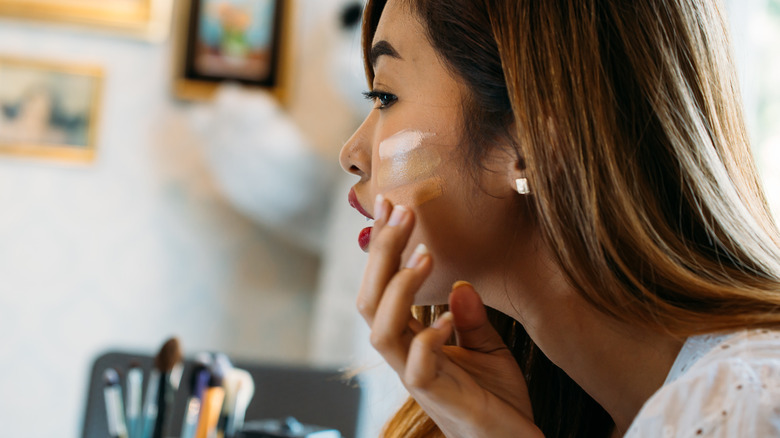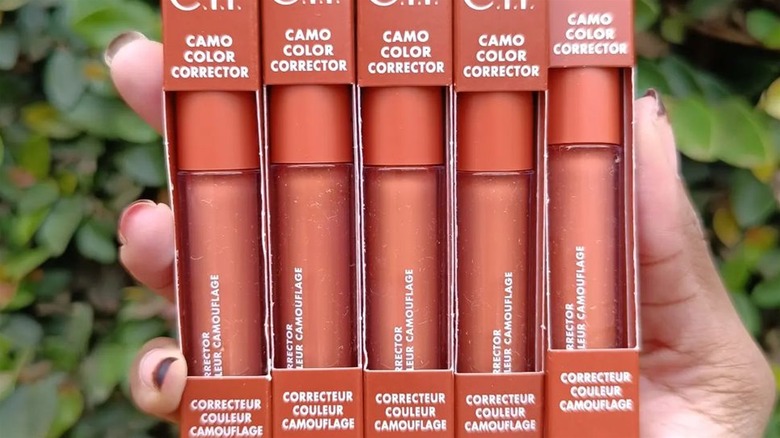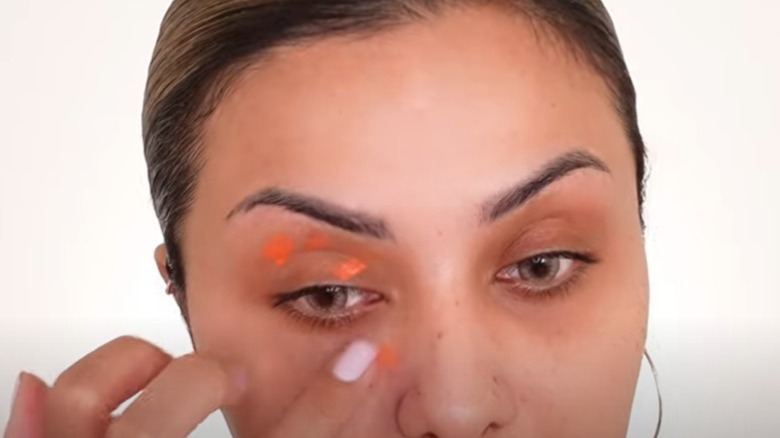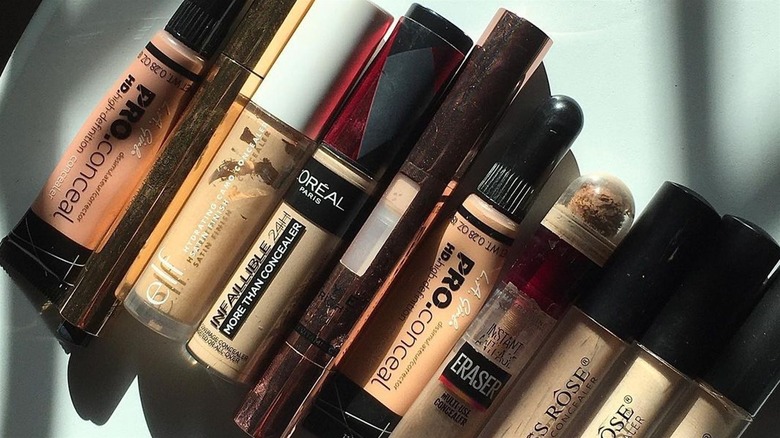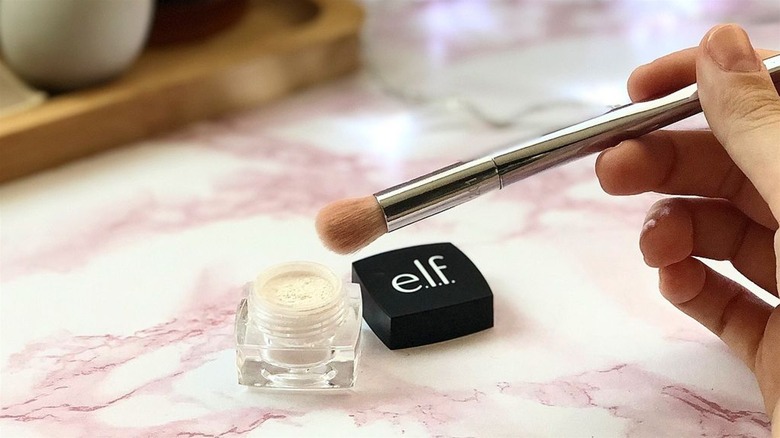How To Use Orange Concealer To Banish Dark Circles
You've probably heard of color correction in makeup before, and you may have seen YouTubers and other beauty influencers layering on orange creams to camouflage their dark circles. After years of being sold yellow and white concealers, it almost seems counterintuitive — Why put a super bright, loud color on an area you're trying to draw attention away from? Well, if you look at a color wheel, you'll notice orange is opposite blue/violet, making them complementary shades. As a result, orange can be used to cancel out the blues and purple tones that create dark circles. This is especially helpful for those with medium or deep skin tones. Dark circles typically show up as deep blue or purple on medium skin, rather than grey, so neutralizing those colors before applying foundation will allow you to create a truly even complexion.
"If you have that veiny undertone or that kind of purple or bluish darkness within [and] around the eye area, then that orange really helps to just cover up that area and brighten it up and just cancel out that blue and purple," YouTube and beauty influencer Nina Ubhi confirmed in a YouTube video. While that sounds great, there is a right (and wrong) way to use this makeup secret weapon. Allow us to take you through the process of orange concealer, step-by-step, so you can say goodbye to dark under eyes in no time.
Start by finding your perfect orange tinted products
As with most makeup, orange concealer isn't one-size-fits all. For natural-looking results, makeup artist Jenny Patinkin advises choosing a shade of orange that mirrors the depth of your skin tone. "For lighter skin tones, think more of a sherbet or sorbet orange, and for deeper skin tones, think of the color inside of a ripe cantaloupe or apricot," she told IPSY.
Once you've determined your best shade, you'll need to work out if a concealer will work on its own, or if you need a color corrector, too. While concealer helps to brighten and create an even base overall, it doesn't actually neutralize existing discoloration.
If you feel your dark circles are on the milder side, a concealer with an orange undertone might be sufficient. However, if your undereye circles are a darker blue or violet shade, then you may need both. Depending on the depth of your dark circles (and how blue they are) you'll want to choose an orange corrector that corresponds to it on the color wheel. A peachy orange can help neutralize blues on light to medium skin tones, whereas a medium orange corrector is better for addressing discoloration on tan to deep skin tones.
Dab, don't swipe
Before applying any product to the under eye, it's important to first hydrate the area. Nina Ubhi explained in her YouTube tutorial that if you tend to have products crease under the eye, you may also want to also apply an eyeshadow primer, as this could prevent your corrector from sinking into any fine lines.
Once your moisturizing and priming product has absorbed into the eye, it's time to apply your corrector. If you're using a cream formula, Ubhi recommends warming it up with your fingers before applying it to the face, as this will help it to blend better. After that, she says to dab dots of the corrector onto the under eye areas that are the darkest. Quinn Murphy, a celebrity makeup artist and the host of the "In My Chair" podcast, explained that less can be more here. "The key is to apply it only where there is darkness, so that you don't see the orange hue," she told Real Simple.
Then comes time to blend, which Ubhi shared is usually done best with a blending brush. In her video tutorial, Ubhi demonstrates how she press esthe product into the skin rather than sliding it around. That's because too much swiping will only thin out the color corrector, rendering it less effective. "You need to be able to see that orange slightly," Ubhi explained. That means having a slight orange wash over all of the dark areas you want to neutralize.
Apply concealer with a dot
Next up, it's time to add concealer. If you have a warm undertone, choose a concealer with a yellow undertone, and if you're cool, choose a product with a pinkish hue. Using your ring finger, a sponge, or a tiny brush, press a thin layer of concealer over your under eyes in a half circle shape. Apply also to any areas with blemishes. Be sure to go over every part that's covered in orange corrector to keep the unnatural shade from shining through.
Focus on applying the most product to the darkest areas so that the orange in the corrector can really work its magic. "Usually it's the inner third of the eye and a bit at the outer corner," makeup artist Romy Soleimani explained to Vogue. Jenny Pantikin recommended having a light hand to IPSY, but suggested using just enough concealer to get the coverage you need. "Use the least amount you can and gently tap it onto the skin with a brush," she said. Then, using your finger, gently blend the product out until everything is the same shade. Be careful not to drag the product around the face too much, otherwise you'll create streaks.
Set with powder
The final, and perhaps most essential step to getting the most mileage out of your orange concealer is to set it with powder. Makeup mogul Bobbi Brown confirmed this to Cosmopolitan UK, noting that an under eye that's not properly set can result in creasing, or worse, cause your other makeup to smudge. "Even if you plan to finish your look with a finishing spray, don't skip applying powder underneath your eyes it will help make the skin appear smoother, thus helping reduce the appearance of dark circles," Sarah Egan, makeup artist on "Late Night With Seth Meyers," said to IPSY.
You'll want to keep this dusting of powder light though if you have dry undereyes, as powder can sometimes make a dry area appear even drier. "Start light, as if you were painting a pointillist. The easiest and most popular mistake is layering too much, which creates another concern to deal with (read: clumpy concealer that counter productively makes you look more tired)," Jamie Greenberg told Real Simple, also noting translucent powder can work well for the undereye area. For many people with a lighter skin tone, a translucent powder will help to keep the undereye looking brighter than it would with a yellow powder. All that's left to do next? Sit back and admire your handy work after banishing those dark circles.
